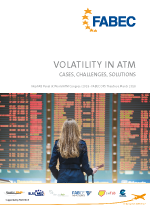Traffic Volatility
Predicting the unpredictable
Volatility describes a new trend underway since the turn of the century. Previously air traffic grew in a roughly linear fashion and along established traffic flows. This pattern stopped abruptly in 2007 with a sharp fall in demand that was not recovered until 2016. Moreover, the growth was accompanied by peaks and troughs that were unlike anything experienced previously.
Regional areas of conflict, for example in Syria and the Ukraine, have changed European traffic flows significantly, and travel advisories in response to political unrest, for example in North Africa, the Arab States and Turkey, have led to a shift in the popularity of holiday destinations. Traffic flows along the south-west axis – towards Spain and Portugal – and along the south-east axis over southern Germany, both experienced unexpectedly high growth in 2018, causing some control sectors to face double-digit growth rates. Traffic within FABEC has become volatile with regard to both the number of flights and their traffic flows.
Similar patterns characterise post-COVID recovery. Local control sectors become overloaded while others have only single flights. The variations can occur on weekdays or weekends, morning or afternoon. Planning resources and capacity is a major challenge and safeguards such as buffers have to be introduced.
Research Workshop
Volatility in Air Traffic and its impact on ATM Performance
15-16 May 2018 in Warsaw/Poland
Baltic FAB and FABEC organised a research workshop "Volatility in Air Traffic and its impact on ATM performance" taking place on 15-16 May 2018 in Warsaw. The conference has being held in partnership with the German Aviation Research society (G.A.R.S.) and the SGH Warsaw School of Economics.
Presentations can be found here:
- Panel 1 G. Guastalla, D. Maresca_Air traffic volatility and traffic_demand balancing.pdf
- Panel 1 J-M. Edard, T. Hellbach_Towards more predictability.pdf
- Panel 2 P. Zagrajek, A. Hoszman_Impact of ground handling.pdf
- Panel 3 T. Laursen_Volatility in ait traffic.pdf
- Panel 3 V. Deltuvaite, S. Murauskas_Main determinates of volatility.pdf
- Panel 4 F. Fichert_Strategic airspace capacacity planing.pdf
- Panel 4 T. Standfuss, M. Schultz_Efficiency gains through flight centered ATM.pdf








